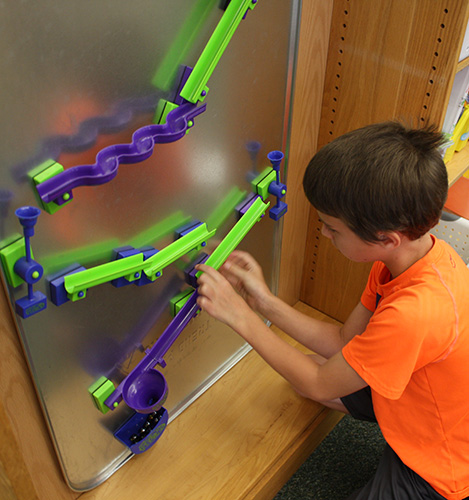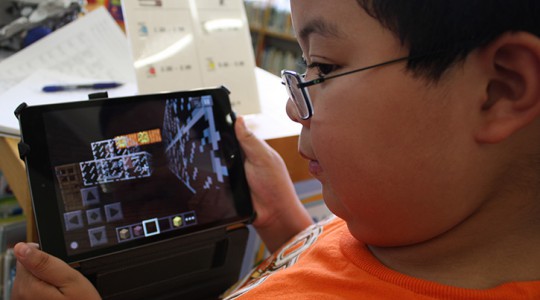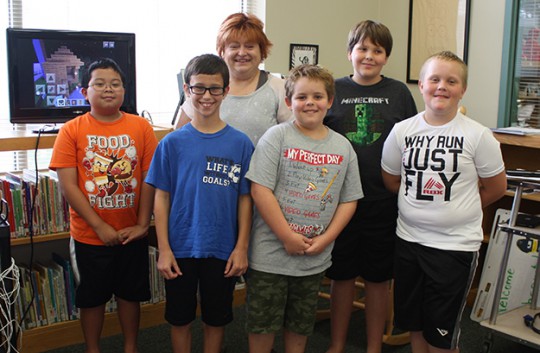Pine Meadow Making Space For Makerspaces
August 5, 2015
Makerspaces are coming to Escambia County Public Schools this year according to Superintendent Malcolm Thomas. This is just one part of his Vision 2020 plan that he is rolling out to administrators and teachers this week as the district prepares for the start of the 2015-2016 school year.
Makerspaces are creative, DIY spaces where people can gather to create, invent, and learn.
“Schools and education are improving, but the world is changing at a pace faster than our improvement trajectory,” Thomas told a group of administrators and teachers who attended the district’s Administrator’s Conference last Friday. “We have to be able to prepare the workforce of the future. We cannot sit and wait for the future, we must lead and prepare for the future.”
Makerspaces are one of the ways schools will be helping children of today prepare to be the life-long learners and creative leaders of our future is by going back to an old fashioned concept of letting kids explore, experiment and learn through trial and error in a safe environment. One school that is already onboard with this idea is Pine Elementary School where the school’s media specialist, Debby Dorough, found out about Makerspaces on Pinterest and decided to try it.
“I started small with Legos and tinker toys. I set up a space with materials and no directions – just build something, take a picture of your creation and then take it apart for the next person,” Dorough explained.
 This summer, Dorough continued to develop this plan with special events in their library every Wednesday in July. Different groups of students met at different times throughout the day. One group was learning how to be this year’s library helpers while others were learning how to be Pine Meadow’s Techspurts (technology helpers). She also had an hour for teachers, so they could learn new technology tricks and techniques over the summer, such as how to use a green screen or how to use an Apple TV in their classrooms.
This summer, Dorough continued to develop this plan with special events in their library every Wednesday in July. Different groups of students met at different times throughout the day. One group was learning how to be this year’s library helpers while others were learning how to be Pine Meadow’s Techspurts (technology helpers). She also had an hour for teachers, so they could learn new technology tricks and techniques over the summer, such as how to use a green screen or how to use an Apple TV in their classrooms.
Then at 2:00 the Minecraft Club met. Once they helped each other learn the program, they agreed upon a rubric for designing a virtual school.
“They decided what to include, like classrooms, a bus ramp, a cafeteria, etc. Then they put their own spin on it, like having a lava pit in the principal’s office,” Dorough added with a laugh. “They designed on iPad minis and presented using an AppleTV which allowed everyone to see their design as they took everyone on a virtual tour.”
“I tried to make the cafeteria look like a replica of the Crusty Crab,” explained incoming fifth grader, Michael Bui to his friends. Why the Crusty Crab? “I like Sponge Bob.”
Meanwhile, Griffin Lavallee a third grader this year, explored how the marble run worked in another Makerspace. His goal was to get the marble to run a course from the top to the bottom without jumping the track. When he finally got all of the pieces to cooperate, he was able to drop a series of marbles into the top and have them end up in a reservoir piece at the bottom. He was quite triumphant and explained that he figured out that he had to “move things to make them workout and you have to figure the timing out (between the marbles) not from the top but, from where your marble got stuck.”
He presented his marble course to Mrs. Dorough and proudly told her he had named the marble run, the Spinner McWinga!
Trial and error in a safe environment. Encouragement to try something with no right answer – to instead find YOUR best answer. These ideas are just a start of what can come from time in Makerspaces.
“Escambia County school teachers will be asked this year to try this and then to share their ideas on Pinterest,” said Thomas. “Our district Fine Arts coordinator, Angela Barberi has set up iVision2020 on Pinterest for us, so everyone will have somewhere to post their ideas and photos of their examples. In addition, even I have pinned sites I hope our teachers will find inspiring.”
Another key element of Makerspaces success is “plussing.” Teachers are “plussing” when they borrow what’s good about an idea and make it better. Ideally, there is no limit to the number of times an idea can be plussed.
Creating Makerspaces in libraries, technology labs and classrooms will take thinking out-of-the-box and it will take sometime to select an idea and acquire materials needed to match that idea. All sorts of items can be used in a Makerspace. They are only limited by imagination, space and materials – so really, the sky’s the limit.
“Librarians this year will love donations of fun materials. They can be new or gently used,” added Dorough. “If your kids loved it, our kids will love it as well.”
Some suggestions are Legos, Duplos, K’nex, Imaginex and other building toys; puppets for story creation; dolls with clothes for kids interested in fashion design; magnets and art supplies. Another item schools can use are board games, dice and pieces for students to repurpose and create their own games.
Other items can help schools set up the stations, for example, oil drip pans or large cookie sheets help create a station like the marble run while large dry marker boards can be mounted or even turned into table tops. Another idea is to use flat green Lego building foundation flats and put them side by side on a board that can be safely mounted vertically, so kids can use Legos to build something that will come out from the board allowing them to work in 3D in a new way.
Those interested in helping accomplish this, can contact their favorite school or those interested in helping on a larger scale, can contact the Community Involvement Office by calling 850-469-5676, or by emailing Jo McArthur, ECSD Community Involvement Coordinator, at jmcarthur@escambia.k12.fl.us.
Pictured top: Michael Bui, 5th grader at Pine Meadow Elementary School designed his perfect school using Minecraft on an iPad mini during July meetings of Pine Meadow’s Minecraft Club. At their final meeting on July 29th, club members took turns leading club members on virtual tours of their schools on an AppleTV. The cafeteria in Hui’s school was designed to resemble Sponge Bob’s Crusty Crab. Pictured inset: Griffin Lavallee, a third grader this year at Pine Meadow Elementary School, makes adjustments to the pieces of the marble run. Pictured below: Pine Meadow Elementary School librarian and Makerspace coordinator, Debby Dorough and the Minecraft Club presenters after the virtual tours of their perfect schools designed using Minecraft and presented wirelessly over the AppleTV. Photos for NorthEscambia.com, click to enlarge.





Comments